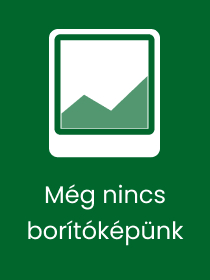
The Uralic Languages
Sorozatcím: Routledge Language Family Series;
-
10% KEDVEZMÉNY?
- A kedvezmény csak az 'Értesítés a kedvenc témákról' hírlevelünk címzettjeinek rendeléseire érvényes.
- Kiadói listaár GBP 220.00
-
108 570 Ft (103 400 Ft + 5% áfa)
Az ár azért becsült, mert a rendelés pillanatában nem lehet pontosan tudni, hogy a beérkezéskor milyen lesz a forint árfolyama az adott termék eredeti devizájához képest. Ha a forint romlana, kissé többet, ha javulna, kissé kevesebbet kell majd fizetnie.
- Kedvezmény(ek) 10% (cc. 10 857 Ft off)
- Kedvezményes ár 97 713 Ft (93 060 Ft + 5% áfa)
Iratkozzon fel most és részesüljön kedvezőbb árainkból!
Feliratkozom
108 570 Ft

Beszerezhetőség
Becsült beszerzési idő: A Prosperónál jelenleg nincsen raktáron, de a kiadónál igen. Beszerzés kb. 3-5 hét..
A Prosperónál jelenleg nincsen raktáron.
Why don't you give exact delivery time?
A beszerzés időigényét az eddigi tapasztalatokra alapozva adjuk meg. Azért becsült, mert a terméket külföldről hozzuk be, így a kiadó kiszolgálásának pillanatnyi gyorsaságától is függ. A megadottnál gyorsabb és lassabb szállítás is elképzelhető, de mindent megteszünk, hogy Ön a lehető leghamarabb jusson hozzá a termékhez.
A termék adatai:
- Kiadás sorszáma 2
- Kiadó Routledge
- Megjelenés dátuma 2023. március 31.
- ISBN 9781138650848
- Kötéstípus Keménykötés
- Terjedelem1034 oldal
- Méret 234x156 mm
- Súly 1680 g
- Nyelv angol
- Illusztrációk 19 Illustrations, black & white; 12 Halftones, black & white; 7 Line drawings, black & white; 413 Tables, black & white 718
Kategóriák
Rövid leírás:
The Uralic Languages, second edition, is a reference book which brings together detailed discussions of the historical development and specialized linguistic structures and features of the languages in the Uralic family.
TöbbHosszú leírás:
The Uralic Languages, second edition, is a reference book which brings together detailed discussions of the historical development and specialized linguistic structures and features of the languages in the Uralic family.
The Uralic languages are spoken today in a vast geographical area stretching from Dalarna County in Sweden to Dudinka, Taimyr, Russia. There are currently approximately 50 languages in the group, the largest one among them being the state languages Finnish, Estonian, and Hungarian; other Uralic languages covered in the book are South Saami, Skolt Saami, V?ro, Moksha Mordvin, Mari, Udmurt, Zyrian Komi, Mansi, Khanty, Nganasan, Forest and Tundra Enets, Nenets, and Selkup. The book also contains a chapter on Finnic languages, the reconstruction of Uralic, the history of Uralic studies, connections of Uralic to other language families, and language names, demographics, and degrees of endangerment. This second and thoroughly revised edition updates and augments the authoritative accounts of the first edition and reflects recent and ongoing developments in linguistics and the languages themselves, as well as our further enhanced understanding of the relations and patterns of influence between them. Each chapter combines modern linguistic analysis and documentary linguistics; a relatively uniform structure allows for easy typological comparison between the individual languages.
Written by an international team of experts, The Uralic Languages will be invaluable to students and researchers within linguistics, folklore, and Siberian studies.
TöbbTartalomjegyzék:
List of contributors
Acknowledgements
List of abbreviations
1. Introduction to the Uralic languages, with special reference to Finnish and Hungarian
Daniel Abondolo and Riitta-Liisa Valijärvi
2. On the demography, endangerment, and revitalization of the Uralic languages
Tapani Salminen
3. Reconstruction of Proto-Uralic
Mikhail Zhivlov
4. Connections between Uralic and other Language Families
Stefan Georg
5. Notes on the history of Uralic linguistics
Péter Simoncsics
6. South Saami
Torbjörn Söder
7. Skolt Saami
Timothy Feist
8. North and Standard Estonian
Reili Argus and Helle Metslang
9. V?ro South Estonian
Helen Plado, Liina Lindström and Sulev Iva
10. The Finnic Languages
Riho Grünthal
11. Moksha Mordvin
Jack Rueter
12. Mari
Jeremy Bradley and Jorma Luutonen
13. Udmurt
Pirkko Suihkonen
14. Zyrian Komi
Rogier Blokland
15. Mansi
Susanna Virtanen and Csilla Horváth
16. Khanty
Márta Csepregi
17. Nganasan
Beáta Wagner-Nagy
18. Enets
Olesya Khanina and Andrey Shluinsky
19. Nenets
Nikolett Mus
20. Selkup
Gerson Klumpp and Josefina Budzisch
21. Relative clauses in Uralic
Ksenia Shagal
22. Definiteness
Merlijn de Smit and Gwen Eva Janda
Index
Több









